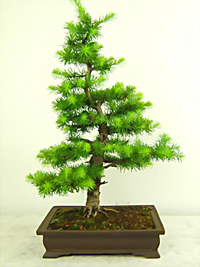Larches grow in a northern belt of the world starting in northwestern United States through Canada and northern Europe, into the great forests of Russia and finally terminating in northern Japan. There is a total of about thirteen species with three occurring in the United States. The go-to means of sorting out plant species are botanical keys, and the keys for the American species indicate the differences between the three species are pretty subtle. So, for all practical means, all the native species can be lumped into a single group as potential bonsai trees.
Larches are conifers and have small cones that look a lot like small pine cones. Field observation indicates the wild growing larches begin to bear cones when they are somewhere between 50 and 150 years old, so if you are looking for cones on your bonsai, don’t hold your breath, or at least plan for a very long life.
The trees look a lot like cedars. Both have buds which grow rosettes of needles. The big distinction between larches and cedars is that larches are deciduous and cedars are not. Larches belong to a small group of deciduous conifers. The bald cypress, dawn redwood and pond cypress are other examples. Deciduous conifers form cones and sprout needles, but also change colors in the fall and lose their needles every year like deciduous trees.
Larches make wonderful bonsai and are frequently seen in bonsai shows in the northern United States where collected trees are readily available. Because they grow in northern climates, they are very cold hardy. They are also exposed to summer rains and short, warm and humid summers which gives us a big clue about their cultural needs. They appreciate a somewhat wetter environment than most of the rest of the bonsai that we typically grow. In fact, they are frequently found in the wild in swampy environments.
We usually use a bonsai mix of equal parts akadama, pumice and lava for most of our trees. Probably a mix for these trees that retains more moisture and which contains at least two thirds or considerably more akadama would work best. The trees are vigorous growers and can be regularly pruned back. Be sure to leave at least two buds on each branch that you cut back. As in the case with most of our trees, vigorous branches will shade the weaker interior branches, causing them to eventually die out, and this should be taken into account when you style your tree. While the tops grow vigorously, the roots grow a little more reluctantly. When repotting larches, care should be taken to disturb the roots as little as possible and avoid heavy root pruning. The trees respond well to application of high nitrogen fertilizer in the spring.
Larches offer spectacular fall color and the possibility for quickly growing into a superb bonsai. What more could you ask for in a bonsai tree?

